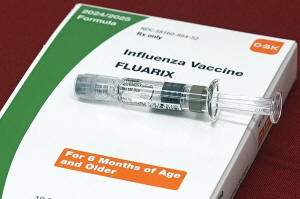Flu season in the US is the most intense it's been in at least 15 years
 Send a link to a friend
Send a link to a friend
 [February 08, 2025]
By MIKE STOBBE [February 08, 2025]
By MIKE STOBBE
NEW YORK (AP) — The U.S. winter virus season is in full force, and by
one measure is the most intense in 15 years.
One indicator of flu activity is the percentage of doctor’s office
visits driven by flu-like symptoms. Last week, that number was clearly
higher than the peak of any winter flu season since 2009-2010, when a
swine flu pandemic hit the nation, according to data posted Friday
morning by the Centers for Disease Control and Prevention.
Of course, other viral infections can be mistaken for flu. But COVID-19
appears to be on the decline, according to hospital data and to CDC
modeling projections. Available data also suggests another respiratory
illness, RSV, has been fading nationally.
The flu has forced schools to shut down in some states. The Godley
Independent School District, a 3,200-student system near Fort Worth,
Texas, last week closed for three days after 650 students and 60 staff
were out Tuesday.
Jeff Meador, a district spokesman, said the vast majority of illnesses
there have been flu, plus some strep throat. He called it the worst flu
season he could remember.

So far this season, the CDC estimates, there have been at least 24
million flu illnesses, 310,000 hospitalizations and 13,000 deaths —
including at least 57 children. Traditionally, flu season peaks around
February.
Overall, 43 states reported high or very high flu activity last week.
Flu was most intense in the South, Southwest and western states.
In Rochester, New York, the flu season has been intense but not
necessarily worse than at the peak of other years, said Dr. Elizabeth
Murray, a pediatric emergency medicine doctor at the University of
Rochester Medical Center.
She said there’s a lot of flu, but there’s also still a lot of RSV and a
surprising number of babies with COVID-19.
“All of the respiratory illnesses are around, with a vengeance,” Murray
added.
The CDC declined to let an Associated Press reporter speak to an agency
flu expert about recent trends. The Trump administration ordered a
temporary “pause” on health agency communications and has continued to
refuse interview requests that were routinely granted in the past.
[to top of second column]
|

A flu vaccine is displayed at a pharmacy in New York, on Tuesday,
Sept. 24, 2024. (AP Photo/Mary Conlon, File)
 Late Friday afternoon, a CDC
spokesperson acknowledged that the new data shows “the highest
absolute value” of flu-like illness when compared with other
seasons, but added that the statistic is complicated: That value
references a baseline estimate for doctor’s office visits, but the
baseline is recalculated every year. In late January, the CDC was
describing the season as “moderate” in severity.
U.S. health officials recommends that everyone 6 months and older
get an annual flu vaccination.
About 44% of adults got flu shots this winter, the same as last
winter. But coverage of children is way down, at about 45% this
winter. It’s usually around 50%, according to CDC data.
About 23% of U.S. adults were up to date in their COVID-19
vaccinations as of late January, up from about 20% at the same point
in time the year before. COVID-19 vaccination rates for kids were
about the same, at around 12%.
The government has not yet reported its estimates of how well this
season's flu vaccine is working.
Testing results from patients indicate that two strains of seasonal
flu that are causing most illnesses — a Type A H1N1 and a Type A
H3N2. Health officials are closely watching a third strain — a bird
flu known as Type A H5N1 — that has sickened tens of millions of
animals, but is known to have infected only 67 people in the U.S.
To avoid seasonal viruses, doctors say you should avoid touching
your eyes, nose and mouth because germs can spread that way. You
should also wash your hands with soap and water, clean frequently
touched surfaces and avoid close contact with people who are sick.
All contents © copyright 2025 Associated Press. All rights reserved
 |